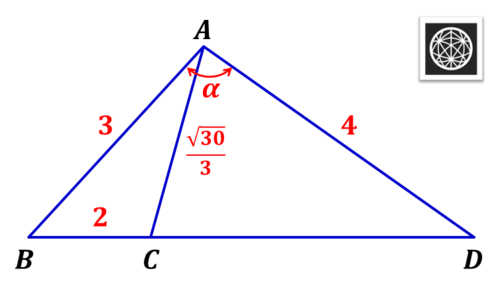Triangle
 See the picture above. It is known
A
B
=
3
cm
,
A
C
=
3
3
0
cm
,
A
D
=
4
cm
, and
B
C
=
2
cm
. If
∠
B
A
D
=
α
, then
sin
α
=
q
p
.
Calculate
p
−
q
.
See the picture above. It is known
A
B
=
3
cm
,
A
C
=
3
3
0
cm
,
A
D
=
4
cm
, and
B
C
=
2
cm
. If
∠
B
A
D
=
α
, then
sin
α
=
q
p
.
Calculate
p
−
q
.
The answer is 431.
This section requires Javascript.
You are seeing this because something didn't load right. We suggest you, (a) try
refreshing the page, (b) enabling javascript if it is disabled on your browser and,
finally, (c)
loading the
non-javascript version of this page
. We're sorry about the hassle.
4 solutions
very good...
I used Heron's formula to find the area of the triangle and then used A r e a = 2 1 b c sin ( A ) to work out sin α of the triangle.
Log in to reply
Can you please elaborate ? Since BD is not known I would like to understand how you used Heron's formula.
A p p l y i n g S i n a n d C o s R u l e s a n d S i n 2 A + C o s 2 A = 1 t h e f o l l o w i n g a n g l e s a r e f o u n d . I n Δ A B C , C o s B = 2 ∗ 2 ∗ 3 2 2 + 3 2 − 3 1 0 = 3 6 2 9 . ⟹ S i n B = 3 6 1 ∗ 3 6 2 − 2 9 2 = 3 6 4 5 5 I n Δ A B D , S i n D = S i n B ∗ A D A B = 3 6 4 5 5 ∗ 4 3 = 4 8 4 5 5 ⟹ C o s D = 4 8 1 ∗ 4 8 2 − 4 5 5 = 4 8 4 3 ∴ S i n α = S i n ( B + D ) = S i n B ∗ C o s D + C o s B ∗ S i n D = 3 6 4 5 5 ∗ 4 8 4 3 + 3 6 2 9 ∗ 4 8 4 5 5 = 3 6 ∗ 4 8 4 5 5 ∗ ( 4 3 + 2 9 ) = 3 6 ∗ 4 8 4 5 5 ∗ 7 2 = 2 4 4 5 5 = q p p − q = 4 5 5 − 2 4 = 4 3 1 .
I manually solved the angles
Use cosine rule for triangle ABC and find angle B then use again cosine rule for triangle ABD to find the length BD. Once more use cosine rule to find angle 'alpha'.
# Q . E . D . #